|
EC Report |

|
In a sense, the 2006 Watertribe Everglades Challenge for Chuck Leinweber and me was two contests. One was to get the boat ready on time, the second was to complete the course. A Duckworks article in February outlined some of the changes that were made to get Oaracle, our Jim Michalak-designed Frolic2, prepared. This report will tell how those changes worked out, and give a few other lessons learned. Chuck will be providing a complete narrative of our adventure in the May/June issue of Small Craft Advisor, as well as posting scads of pictures on Duckworks.
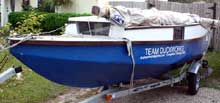 |
"Oaracle" our Frolic2 - the lettering, unfortunately, came too late for the race.
(click images for larger views) |
|
Helen and I suffered greatly in our 2004 Everglades Challenge attempt from the lack of decent cushions, something I went on extensively about in the February article. That wasn’t a problem this time. The life-vest cushion covers we sell through Duckworks worked magnificently. The covers hold two standard orange life vests each; they seemed a little high for Oaracle so I made covers that hold only one vest and they worked fine. (If anyone else wants single vest covers, we can make them, but they will cost almost as much because the labor time is the same and they save only about 3 inches of material) The caned canoe seat planned for rowing didn’t arrive in time, so I cut down a curved, portable cedar seat from a rowing boat. It worked well, with a life vest cushion for long stints at the oars and by itself for quick bursts.
| Helen and I suffered greatly in our 2004 Everglades Challenge attempt from the lack of decent cushions. That wasn’t a problem this time. The life-vest cushion covers we sell through Duckworks worked magnificently. |

|
|
The 13-square foot mizzen added to help counteract a slight lee helm when on the wind and to help control the boat when the main is being raised, lowered, or reefed; it did the job I intended it to. On the first day when we had to reef the main, it helped control the boat, and also later when we had to shake the reef out, and then put it back again. We spent the first and third nights at anchor (the second night, we were sailing), and the mizzen kept the boat pointed into the wind. The mizzen came down on the fourth day to ease the weather helm as we were blast reaching down the coast toward Cape Sable, on Florida’s southwest tip. We didn’t put it back up for the last sail across Florida Bay, and probably should have. We spent much of the morning and early afternoon close reaching and hard on the wind in narrow, shallow channels and shallow bays. That meant the leeboard couldn’t be fully extended, which created some lee helm. The mizzen would have offset some of that, We also had a polytarp jib of about 50 square feet. That was used on the first day for an hour or so, when the wind went light. One of the 2x2 four-foot sticks we used under PVC pipe to beach launch the boat was jury rigged as a whisker pole, and we ran wing and wing. It seemed to help. On the second night when we were broad reaching at around 4 mph, we could have reset the jib, but the conditions seemed too perfect to mess with it. We’ll call the mizzen a success and say the jury is still out on the jib.
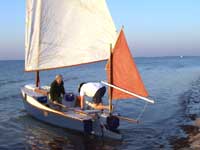 |
The 13-square foot mizzen added to help counteract a slight lee helm when on the wind and to help control the boat when the main is being raised, lowered, or reefed; it did the job I intended it to.
|
|
The jury isn’t out on the “oardles,” the hybrid oar/paddles that were made from a donated double paddle from a local Tallahassee kayak/canoe shop, Wilderness Ways. They were a resounding success. To get to Checkpoint 1 on the Challenge, it’s necessary to pass under a bridge with 9 feet of vertical clearance (so the mast must be down) and where the pilings are only 10-feet apart – too narrow to row. We were able to row up to the bridge, pull out the oardles and use them as long paddles to get under the span, and then reship them as oars and get to the checkpoint – all with a tide slightly against us. My impression is the oardles, with their spoon-shaped blades, outperform both standard commercial oars and the narrow-bladed oars I built with Oaracle. In addition, the plastic blades seem nearly indestructible. A major advantage was storing the oardles on the cabin top in the rubber clips that Duckworks sells in different sizes. It took only a moment to snap the oardles securely in place, and only a moment to snap them out, ready to paddle or row. Also a success were the folding metal steps sold by Duckworks and which were installed on the seat framing as rowing foot braces.
| The rubber clips hold the oardles securely. Here the oardles are stored for trailering, with the blades to the rear to reduce wind resistance. When sailing, the blades go forward to clear the cockpit. The tie down line is used only for trailering for extra security; it's not needed for sailing. That is genuine Florida Bay mud adorning those paddles. |
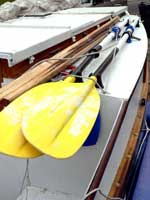
|
|
While not a necessity, the basic electrical system made onboard life easier. The 31-amp hour AGM battery provided more than enough power. It was nice to flip a switch and have a 24-LED light come on in the cabin to help find things at night (Chuck was impressed with its brightness) and the red LED light over the compass provided perfect illumination for night sailing. The battery also came in handy for keeping the charge up on Chuck’s cell phone. I may install LED running lights. The AA battery-powered Tektite lights worked flawlessly, but it was slightly hairy a couple times leaning out of the cabin to fasten the bow lights to the foredeck cleat when the winds were blowing and the sea was bumpy.
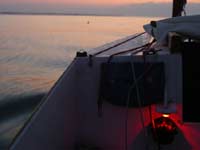 |
Here you can see the rosy glow of the compass LED light as we round cape Romano at dawn.
|
|
The old Forespar Mini B galley obtained on eBay worked well. I was worried it would falter in windy conditions because of a lack of a wind screen, but once lit, it would keep going and heat water. One slight drawback is it took about 20 minutes to boil a quart of water in the coffeepot. Some competitors had the new Jet Boil system, which will boil 8-12 ounces of water in 90 seconds. But, of course, you have to be stopped or at least in calm water to use it.
| You can just see the Forespar Mini B galley with the coffee pot we used to heat water at Chuck's right, mounted on the bulkhead. |
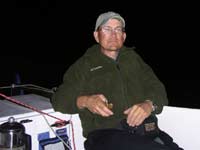
|
|
Our launching system of 2" PVC pipe on 2x2 pieces of wood worked well. Chuck and I practiced the day before and got our technique down so that we had the boat in the water in less than 10 minutes, and the sails up and away from shore in about 15 minutes from the start. That compares to about an hour it took Helen & me in 2004. We had eight of the 2x2s, in four foot lengths (they have to store in the boat during the race). We laid them out as a track extending under the bow of the boat, put a piece of PVC pipe under the bow and at the start of the track, Then we picked up the stern and the boat easily rumbled down the beach, until the PVC ran out of “track.” The 2x2's were re-layed and the second push got the boat in the water.
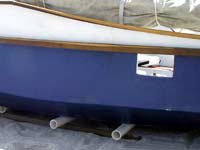 |
Here is "Oaracle" sitting on the pipes and 2x2's that we used to easily move the boat down to the water from the high tide mark.
|
|
As slick as that worked out, we noticed a couple other boats, including the Core Sound 17 that won the race, used big, round, squishy boat fenders under their boats, and made it to the water in a minute or two. They also had the foresight to raise their sails before the start so they hit the water, tossed in their fenders, and were off. Something to consider for future ECs.
One thing not covered in the February article but is well worth praising is the auto-release clamcleats sold by Duckworks. On Oaracle, it’s used on the line that holds down the unballasted leeboard. A lot of the EC is sailed in shallow water and the leeboard and (ballasted) swinging rudder blade are going to hit a lot. With the auto-release cleat, the line would be released with a loud pop, alerting the crew that the board is up and the water is shallow, but not stopping the momentum of the boat and hence giving some maneuvering speed. I don’t mean to sound like a commercial for Duckworks products here, but this may have been the single most important piece of gear on the boat. (A side note: If you’re building a boat for the EC, make sure you fiberglass, preferably with 2 or 3 layers of cloth, the lower leading edges of your centerboard/leeboard and swinging rudder. They’re going to take a lot of abuse. We dragged ours not only through muck and sand, but over a couple oyster bars . . .)
| The leeboard is tied up in this picture taken by Helen before the race |
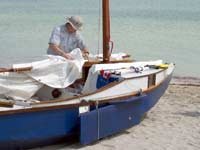
|
|
Those were some of the technical lessons from the 2006 EC. There were also many intangible gems to fit into the ring of experience.
Like learning preparation and experience are vital to a successful campaign. The lack of that was a major problem in 2004, but more time to practice, exercise, and actually use the boat resulted in better handling, and confidence that we and the boat could take what was dished out. We didn’t run into any fog this time, but we were reefed or double-reefed probably half of the time we were out, listening to small craft advisories on the weather radio. It was nice to feel comfortable in those conditions and know the boat could take it.
 |
we were reefed or double-reefed probably half of the time we were out, listening to small craft advisories on the weather radio.
|
|
Also, I learned that everything doesn’t have to be perfect, as long as a reasonable level of preparation is met. For example, Chuck showed me two or three better ways to set up and do things on the boat that will help in the future. Also, my health wasn’t as good as I would have wanted. Chuck compensated for my relatively poor eyesight. And still recovering from a bout of shingles, I hadn’t been able to exercise as much as I wanted. Aside from some residual vertigo, that resulted in me getting worn out a couple times. Not serious, but we had to take it easier than I would have liked a time or two, including walking through the muck in shallow Florida Bay. But it was something that could be compensated for. Drawbacks – yes. Worth missing the EC over – no!
| Savannah Dan and Paddlemaker in their Sea Pearl just getting back underway after being stuck in the Florida Bay muck. |
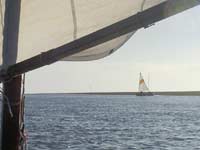
|
|
We learned about the wonderland of Florida Bay. As Chuck accurately noted in his blog, for most of the day we spent crossing the bay, if one of us had fallen out, he just could have stood there and waited for the other person to come back and pick him up. It’s that shallow. Currents and tides do funny things. We were supposedly sailing into the Bay on a rising tide. But if the tide ever came up much, it wasn’t noticeable. Looking at the chart, you’ll think that with a little extra tide, you can finagle the narrow channels that connect the shallow bays of Florida Bay. But you can’t. Get out of the channel and you hit, even in a boat like Oaracle that draws only a few inches. Step out to push, and you sink up to your knees (or deeper) in the muck. Ten yards is an eternity in those conditions. It’s a whole education on using wind, oars, and cunning to get where you’re going. It’s a lesson on the importance of getting good winds. We were the last boat through Florida Bay before the weather door closed (actually, the door caught us by the foot and tripped us in Jimmie Channel – the only place we actually had to get out and push). Every boat behind us faced 15-20 mph headwinds on the sojourn across the bay. But the fish jump, the birds fly, the water is mostly clear and the bottom visible, and watching as osprey sit on one of the grey, weather-beaten poles that mark the channels and eat a large fish is incomparable. I can’t wait to get back.
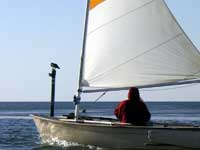 |
If you look closely you can see the fish that the Osprey on the post has in its talons.
|
|
In addition, we learned that caution pays, especially if like us you’re largely unfamiliar with the waters. The best example came at the end of the first day. We were running along at nearly 6 knots, but it was obvious we would not make Gasparilla Inlet to get to Checkpoint 1 during daylight. Chuck suggested going in at Stump Pass, a few miles to the north and which we could do while it was still light, and running down the CP 1 on the Intracoastal Waterway. It cost us some time in dealing with the fast outgoing tide and the lighter winds on the inside, but we later heard other competitors talk about the nasty breaking waves at Gasparilla. One competitor told of surfing sideways into the inlet on a breaking wave. Everyone we talked to agreed going in at Stump Pass was the right decision. As if to confirm that, Matt Layden – AKA Wizard – made the same decision and caught up to us as we were dealing with the tide.
| Bill Paxton got this shot of Matt Layden with his boat "Enigma" on the Friday before the race. |
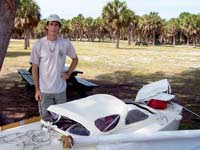
|
|
Maybe the most important lesson is attitude, the outlook of taking each day as it comes and dealing with the conditions Mother Nature provides. On this trip, that meant hanging on and keeping the boat in control on some wild downwind rides and reaches, and drifting and rowing our way through some calms. We only had a total of about 14 miles (as the crow flies) of windward work out of 300 sailed. It’s also learning to roll with the punches. That was perhaps best exemplified by Savannah Dan and Paddlemaker in a Sea Pearl. We caught up to them in the first channel in Florida Bay after they ran aground, and sailed pleasantly in company for more than an hour, finishing that channel and getting to the Dump Key Channel, where we both went aground. Being a lighter boat, we were able to free Oaracle with the oardles, while the other two had to get out and push the heavier Sea Pearl. Consequently, we got between the two small keys in the middle of the channel and through most of that passage about a half an hour ahead of the Sea Pearl, during which time the wind shifted more to the east. We realized they would be unable to follow us in the rest of the channel, and we quickly lost sight of them, and worried about their fate until they finished, relaxed and smiling, the next day. Paddlemaker explained their approach. He said realizing the channel was now impassible, they immediately anchored for a two-hour lunch. “If that hadn’t been enough to solve the problem, we would have had a three-hour lunch,” he said, grinning broadly. Instead of a frustrating day of bumping into banks, they sailed leisurely up to Crocodile Haulover Channel, at the northern end of Florida Bar, and reportedly a jewel of natural splendor. There they anchored for the night. The next morning, relaxed and refreshed, they rowed the four or so miles through Crocodile Haulover, enjoying the scenery, and they had a close reach to the finish. Yeah, we finished the previous evening, but I think I’m jealous. The moral: No one said you have to kill yourself to finish. There are rewards for working with the weather and enjoying the landscape. And no reason not to with a well found boat with plenty of food and water.
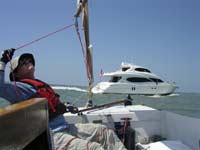 |
Working with the weather and enjoying the landscape: Sunday in Pine Island Sound, the wind quit but the weekend powerboats zoomed by anyway.
|
|
Likewise with problems that inevitably crop up. I found myself getting frustrated when we hit the channel banks in Florida Bay, but except for Jimmie Channel, we were always able to get off by poling and rowing with the oardles. And once we were off, I found myself wondering, “What’s the big deal? Why get upset? We got off without too much difficulty.” There’s a reason it’s called a challenge; there are supposed to be problems to overcome. Being mentally ready is important. And getting past the problems has its own rewards. Even after the exertions of Jimmie Channel, which marked my physical low point, we knew that was the last serious problem between us and the finish line. With the shift in the wind, the last cut, Manatee Channel, would be a reach (finding it was another matter, it’s not charted accurately) and then we just had to beat to Key Largo, which only required patience and attention.
| "Oaracle" rests at the finish line. |
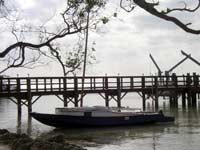
|
|
About five miles out Chuck and I looked at each other and we realized, that barring some fluke, we were going to make it. And the shark tooth necklace, awarded to each finisher, was in our grasp. That’s a nice feeling to discover, too.
 |
Why we did it -- for the sharktooth necklace awarded to all finishers.
|
|

Other articles by Gary Blankenship & Helen Snell:

|